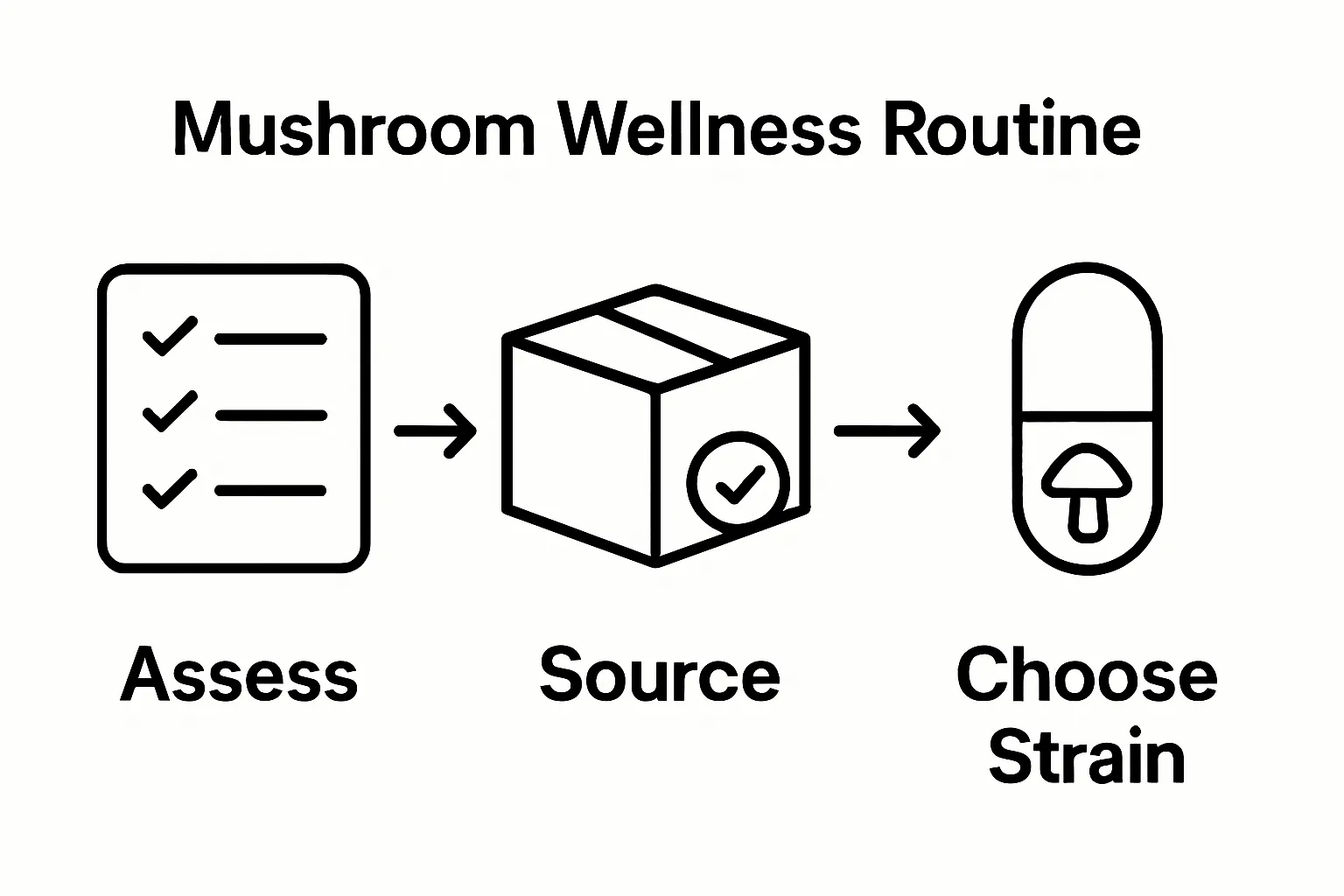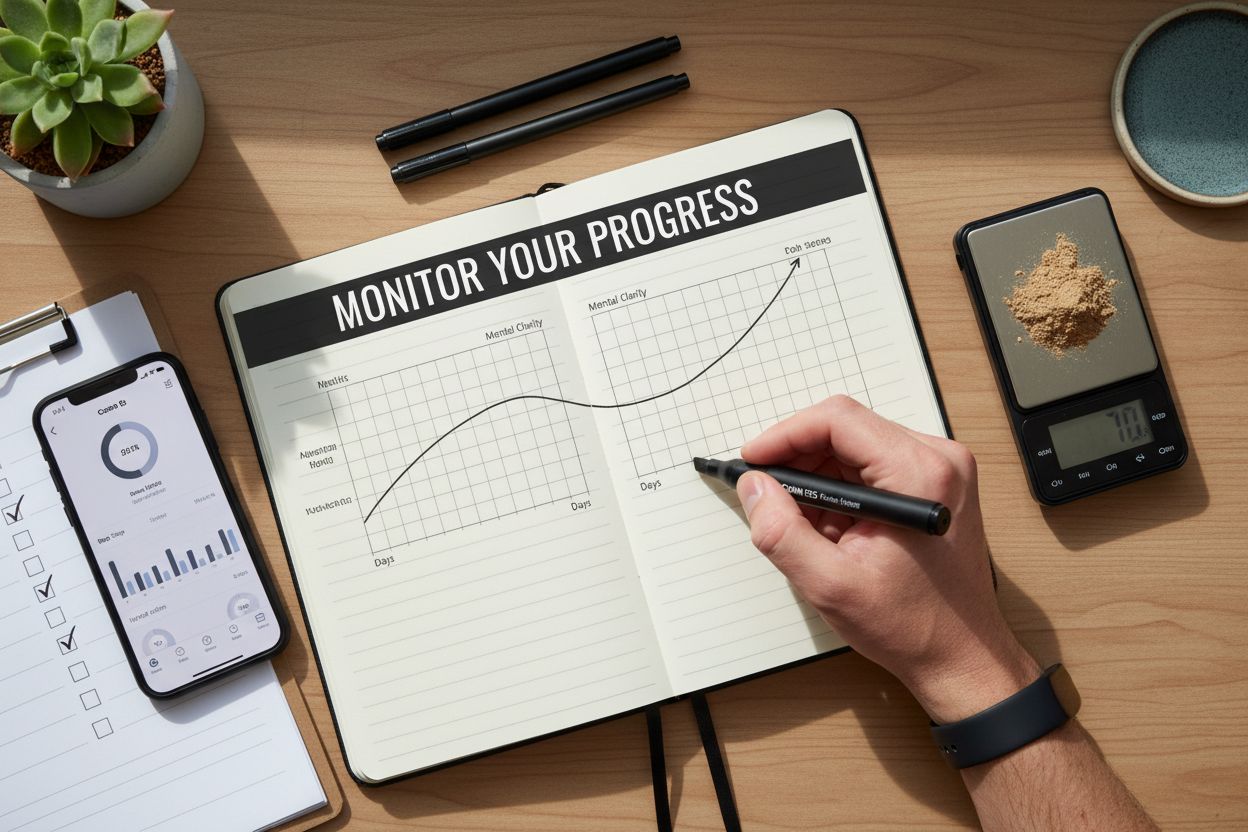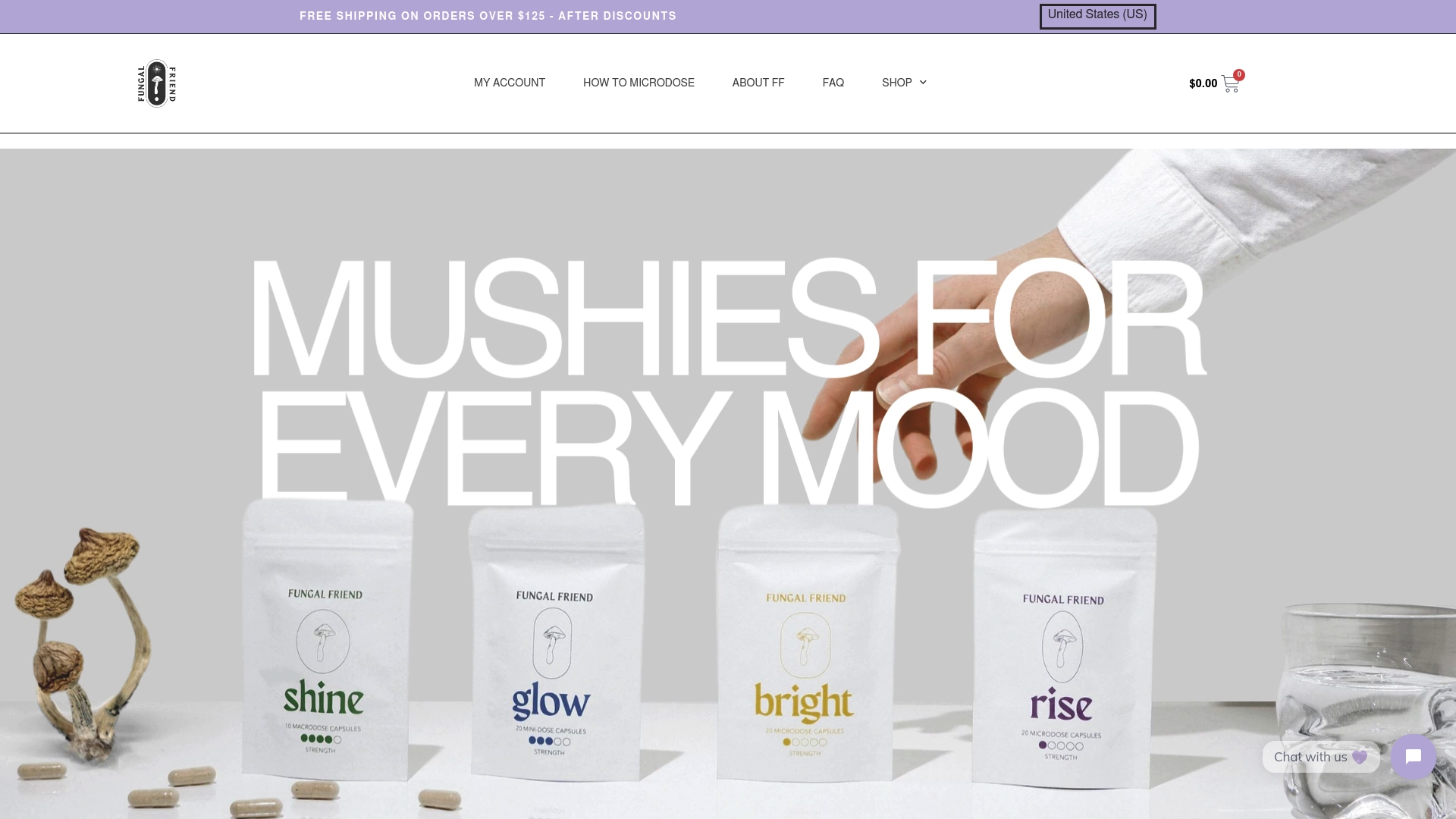Mushroom Wellness Routines for Enhanced Mental Clarity
People are searching everywhere for new ways to sharpen their minds and feel more balanced. It sounds wild but over 70 percent of people interested in mental wellness now consider mushrooms an option for cognitive support. The twist is that it is not just about picking a fancy supplement. The real breakthroughs come from building a legit wellness routine that mixes the right mushrooms with lifestyle upgrades you probably never thought to link together.
Table of Contents
- Step 1: Assess Your Health And Goals
- Step 2: Research Legal And Safe Sources
- Step 3: Choose The Right Mushroom Strain
- Step 4: Develop Your Microdosing Schedule
- Step 5: Monitor Your Progress And Adjust
- Step 6: Incorporate Lifestyle Changes For Balance
Quick Summary
| Key Point | Explanation |
|---|---|
| 1. Conduct a thorough health assessment | Evaluate mental health, stress levels, and cognitive performance to tailor your mushroom wellness routine effectively. |
| 2. Research legal and safe sources | Identify reputable vendors with compliant products through understanding local regulations and transparent information. |
| 3. Select the right mushroom strain | Align mushroom varieties with your specific mental wellness goals, considering their unique properties and effects. |
| 4. Develop a structured microdosing schedule | Implement a consistent dosing routine that prevents tolerance while promoting cognitive benefits through careful tracking. |
| 5. Integrate holistic lifestyle changes | Enhance the effectiveness of your mushroom strategy by focusing on nutrition, exercise, sleep, and stress management techniques. |
Step 1: Assess Your Health and Goals
Designing effective mushroom wellness routines begins with a comprehensive self-assessment that provides a strategic foundation for your mental clarity journey. Understanding your unique physiological and psychological landscape allows you to customize your approach, maximizing potential benefits while minimizing potential risks.
Your initial assessment should explore multiple dimensions of personal wellness. Start by conducting an honest inventory of your current mental health status, daily stress levels, cognitive performance, and specific areas where you seek improvement. Key areas to evaluate include concentration capacity, emotional regulation, sleep quality, and overall energy management.
Reflect deeply on your current challenges. Are you struggling with persistent mental fog? Do you experience frequent anxiety or mood fluctuations? Are productivity and focus becoming increasingly difficult? These insights will help you determine which mushroom wellness strategies might serve you most effectively.
Practical self-assessment techniques can include maintaining a detailed wellness journal for 1-2 weeks prior to starting your mushroom routine. Document your sleep patterns, daily energy levels, emotional states, and cognitive performance. This baseline data will become invaluable when tracking the potential impacts of your chosen mushroom wellness approach.
Consider consulting a healthcare professional who understands functional mushroom interventions. According to the National Center for Complementary and Integrative Health, professional guidance can help you navigate potential interactions with existing medications and personalize your wellness strategy.
Remember that individual responses to mushroom wellness routines can vary significantly. Your assessment should be thorough yet flexible, allowing room for personalized adjustments as you progress. The goal is not perfection but progressive improvement in your mental clarity and overall cognitive wellness.
Successful completion of this step means you have:
- Created a detailed current wellness snapshot
- Identified specific mental performance goals
- Documented baseline health metrics
- Consulted with a healthcare professional (optional but recommended)
- Developed a preliminary understanding of your unique wellness needs
By investing time in this critical first step, you’re laying a solid groundwork for a targeted, effective mushroom wellness routine tailored precisely to your individual requirements.
Step 2: Research Legal and Safe Sources
After completing your personal health assessment, the next critical phase in developing mushroom wellness routines involves navigating the complex landscape of legal and safe sourcing. This step is fundamental to ensuring your mental clarity journey remains both effective and compliant with current regulations.
The legal status of mushroom products varies significantly across different regions, making thorough research an absolute necessity. Your primary goal is to identify reputable sources that provide high-quality, legally compliant mushroom products designed for wellness purposes. This requires a multifaceted approach that goes beyond simple online searching.
Start by understanding the specific legal frameworks in your jurisdiction regarding functional and medicinal mushrooms. Different categories of mushrooms have varying legal classifications, so distinguishing between dietary supplements, research compounds, and controlled substances is crucial. The National Institutes of Health research database can provide authoritative information about mushroom classifications and research status.
When evaluating potential sources, prioritize vendors who provide comprehensive transparency about their products. Look for companies that offer detailed third-party lab testing results, clear ingredient documentation, and explicit information about sourcing and processing methods. Legitimate vendors will be forthcoming about their product’s origin, cultivation techniques, and potential interactions with other substances.
Consult professional healthcare practitioners who specialize in functional medicine or have expertise in botanical supplements. Their guidance can help you distinguish between marketing claims and scientifically substantiated wellness approaches. Check out our Essential Mushroom Safety Checklist for Confident Use for additional screening criteria when selecting mushroom wellness products.
Key verification criteria for selecting safe sources include:
- Transparent lab testing documentation
- Clear product origin information
- Verifiable cultivation and processing standards
- Professional recommendations or endorsements
- Alignment with your specific wellness goals
Successful completion of this research phase means you have developed a critical understanding of legal mushroom wellness sources, identified potential high-quality vendors, and established a foundation for making informed purchasing decisions. Remember, patience and thorough investigation are your best tools in creating a safe, effective mushroom wellness routine.
Step 3: Choose the Right Mushroom Strain
Selecting the appropriate mushroom strain is a nuanced process that requires careful consideration of your specific mental wellness goals. Each mushroom variety offers unique properties that can dramatically influence your cognitive performance, emotional balance, and overall mental clarity.
The diversity of functional mushrooms is remarkable, with each strain presenting distinct therapeutic potential. Lion’s Mane, for instance, stands out for its remarkable neurogenesis support, while Reishi offers profound stress reduction capabilities. Your selection should align precisely with the mental performance outcomes you identified during your initial health assessment.
Comprehensive research from scientific publications demonstrates that different mushroom strains interact uniquely with human neurological systems. Some strains enhance focus and cognitive processing, while others promote emotional stability and stress management. Understanding these subtle distinctions becomes crucial in crafting an effective wellness routine.
Consider creating a detailed comparison matrix of potential mushroom strains. Document each strain’s reported benefits, potential side effects, and alignment with your personal wellness objectives. Factors like bioavailability, recommended dosage, and potential interactions with existing health conditions should guide your selection process.
Consulting with integrative health practitioners or mushroom wellness experts can provide personalized insights into strain selection. These professionals can help you navigate the complex landscape of functional mushrooms, ensuring your chosen strain delivers optimal mental clarity support.
To understand the nuanced signs of high-quality magic mushrooms, develop a critical eye for product authenticity and potency. Look beyond marketing claims and prioritize scientifically substantiated information.
Key considerations when choosing your mushroom strain include:
- Specific mental wellness goals
- Documented scientific research
- Personal health history
- Potential interaction with existing medications
- Recommended dosage and administration methods
Successful strain selection means you have thoroughly investigated multiple options, matched strain characteristics to your wellness objectives, and feel confident in your chosen mushroom variety’s potential to support your mental clarity journey.
Below is a comparison table to help you distinguish between popular mushroom strains and their reported cognitive or wellness impacts, summarizing details already discussed in the section.
| Mushroom Strain | Primary Benefit | Notable Properties | Best For |
|---|---|---|---|
| Lion’s Mane | Supports neurogenesis | Enhances cognitive function, focus | Mental clarity and concentration |
| Reishi | Reduces stress | Promotes emotional balance, relaxation | Stress management |
| (Other medicinal) | Varies | Depends on individual properties | Personalized wellness goals |

Step 4: Develop Your Microdosing Schedule
Developing a strategic microdosing schedule represents a critical junction in your mushroom wellness routine, transforming theoretical knowledge into practical mental clarity enhancement. This step requires meticulous planning, self-awareness, and a nuanced understanding of how mushroom compounds interact with your unique physiological systems.
The fundamental principle of microdosing is subtlety: your goal is achieving cognitive benefits without experiencing perceptible psychoactive effects. This delicate balance demands careful dose calibration and systematic tracking. Research from scientific publications suggests implementing a cyclical approach that prevents tolerance and maintains neurological sensitivity.
A typical microdosing protocol involves consuming a sub-perceptual dose every third or fourth day, creating what experienced practitioners call a ‘dose-rest-dose’ cycle. This rhythm allows your neurological systems to integrate the mushroom’s compounds while preventing potential desensitization. Start with the lowest recommended dose for your chosen mushroom strain, typically ranging between 0.1 to 0.3 grams.
Documenting your experience becomes paramount. Maintain a detailed journal tracking not just dosage, but comprehensive wellness indicators: sleep quality, emotional regulation, cognitive performance, energy levels, and any subtle shifts in mental clarity. Learn more about microdosing protocols in our comprehensive guide, which offers in-depth insights into effective implementation.
Consider your lifestyle and professional commitments when designing your schedule. Some individuals prefer morning microdosing to support daytime cognitive performance, while others might find evening doses more conducive to their rhythms. Experiment cautiously, always prioritizing your safety and well-being.
Critical elements of an effective microdosing schedule include:
- Consistent, measured dosing intervals
- Comprehensive personal tracking
- Flexibility for individual adjustment
- Regular self-assessment
- Professional consultation
Successful schedule development means you have created a personalized, intentional approach to mushroom wellness that respects both scientific understanding and individual variability. Your schedule should feel like a carefully crafted tool for mental optimization, not a rigid, one-size-fits-all protocol.
Step 5: Monitor Your Progress and Adjust
Monitoring your progress represents the most dynamic and personalized phase of your mushroom wellness journey, transforming raw data into actionable insights that continuously refine your mental clarity approach. This step is not merely about passive observation but active interpretation and strategic adaptation.
Comprehensive tracking goes beyond simple note-taking; it requires establishing a systematic method of assessing your cognitive, emotional, and physiological responses to your microdosing routine. Scientific research emphasizes the importance of objective self-assessment to understand the nuanced effects of functional mushrooms.
Develop a multilayered tracking system that captures quantitative and qualitative data. This might include standardized mood scales, cognitive performance tests, sleep quality metrics, and subjective journal entries describing your daily mental landscape. Digital tools and apps can streamline this process, offering structured frameworks for consistent monitoring.
Pay close attention to subtle shifts in your mental clarity, emotional regulation, stress response, and overall cognitive performance. These changes might not always be dramatic but can represent significant neurological adaptations. Look for patterns of improvement in focus, creativity, emotional resilience, and problem-solving capabilities.
Learn more about interpreting your microdosing results in our comprehensive tracking guide, which provides advanced strategies for personal wellness optimization. The key is maintaining a flexible, non-judgmental approach to your data collection and interpretation.
Consult with healthcare professionals or mushroom wellness experts periodically to gain external perspectives on your progress. Their trained insights can help you distinguish between meaningful trends and potential placebo effects or coincidental changes.
Critical elements of effective progress monitoring include:
- Consistent, objective data collection
- Multiple assessment dimensions
- Regular professional consultation
- Willingness to modify your approach
- Patience with personal physiological variations
Successful progress monitoring means you have transformed your mushroom wellness routine from a static protocol into a dynamic, responsive system of mental performance enhancement. Your ability to observe, interpret, and adjust becomes the most powerful tool in your cognitive optimization toolkit.
This checklist table outlines the critical elements to monitor for effective progress tracking throughout your mushroom wellness routine, providing a quick reference for evaluation.
| Progress Tracking Item | Description | How to Monitor |
|---|---|---|
| Cognitive Performance | Changes in clarity, focus, memory | Journaling, cognitive tests |
| Emotional Regulation | Mood shifts, resilience, stress response | Mood scales, reflective journaling |
| Sleep Quality | Duration, restfulness, sleep disturbances | Sleep tracking apps, daily notes |
| Physical Wellness | Energy levels, body awareness | Wellness journal, observation |
| Professional Consultation | Input from healthcare or mushroom wellness experts | Periodic review sessions |

Step 6: Incorporate Lifestyle Changes for Balance
Incorporating holistic lifestyle changes becomes the critical catalyst that amplifies and sustains the neurological benefits of your mushroom wellness routine. Your microdosing practice is not an isolated intervention but a complementary strategy within a broader mental wellness ecosystem.
Nutrition emerges as a fundamental pillar supporting cognitive enhancement. Focus on consuming a diet rich in omega-3 fatty acids, complex carbohydrates, and micronutrients that support neuroplasticity. Incorporate brain-nourishing foods like fatty fish, nuts, leafy greens, and fermented products that complement the neurological support provided by functional mushrooms.
Physical movement transforms from optional activity to essential neurological maintenance. Regular exercise stimulates neurogenesis, increases brain-derived neurotrophic factor (BDNF), and creates physiological conditions that maximize the cognitive benefits of your mushroom wellness routine. Aim for a blend of cardiovascular exercise, strength training, and mindful movement practices like yoga or tai chi.
Sleep hygiene represents another non-negotiable component of your mental clarity strategy. Establish consistent sleep patterns that allow for complete sleep cycles, prioritizing both duration and quality. Create a sleep environment that minimizes digital disruptions, maintains cool temperatures, and supports uninterrupted rest.
Explore our comprehensive guide on integrating wellness practices to gain deeper insights into holistic lifestyle optimization. The synergy between mushroom supplementation and lifestyle modifications can exponentially enhance your cognitive performance.
Stress management techniques become crucial in maintaining the neurological benefits of your mushroom wellness routine. Integrate practices like meditation, breathwork, journaling, and mindfulness to regulate your nervous system and create psychological resilience.
Key lifestyle integration strategies include:
- Consistent nutritional optimization
- Regular, diverse physical movement
- Prioritized sleep hygiene
- Systematic stress management
- Continuous learning and cognitive stimulation
Successful lifestyle integration means transforming your wellness routine from a fragmented approach to a cohesive, interconnected system of mental and physical optimization. Your lifestyle becomes the supportive infrastructure that allows mushroom wellness practices to deliver their full potential.
Unlock Complete Mental Clarity With Fungal Friend
Are you searching for a proven way to overcome daily brain fog, strengthen your focus, or finally find relief from stress and mood swings? The article you just read breaks down the path to mental clarity through mushroom wellness routines, but the true challenge often lies in finding trusted, legal, and effective products that match your unique goals. At Fungal Friend, we understand that safe sourcing, proper strain selection, and evidence-based microdosing are essential for lasting results. We offer educational resources, strain-specific guidance, and carefully crafted microdose products designed with your cognitive performance, emotional resilience, and safety in mind. For more information on our full selection and educational insights, check out our Uncategorized Archives to start building your foundation.

Take control of your mental well-being now with Fungal Friend. Experience the difference of curated psilocybin mushroom products trusted by people across Canada for their quality, safety, and clarity-boosting benefits. Visit us today to explore mushroom capsules, infused teas, and chocolates — and start your own custom wellness routine.
Frequently Asked Questions
What is the first step in creating a mushroom wellness routine for mental clarity?
The first step is to assess your health and goals by conducting a comprehensive self-assessment that evaluates your current mental health status, daily stress levels, cognitive performance, and specific areas for improvement.
How do I choose the right mushroom strain for my wellness routine?
Selecting the right mushroom strain involves understanding each variety’s unique properties in relation to your mental wellness goals. For example, Lion’s Mane supports neurogenesis, while Reishi aids in stress reduction. It’s essential to document each strain’s benefits and potential side effects.
What is a microdosing schedule, and how do I create one?
A microdosing schedule typically involves taking a sub-perceptual dose of mushrooms every third or fourth day, following a ‘dose-rest-dose’ cycle to maintain neurological sensitivity. Start with the lowest recommended dose for your chosen strain and document your experiences.
How can I monitor my progress in my mushroom wellness routine?
Monitoring progress requires establishing a systematic method of tracking your cognitive, emotional, and physiological responses. This involves collecting quantitative data through mood scales and sleep metrics, alongside qualitative journal entries to interpret your overall experience.
